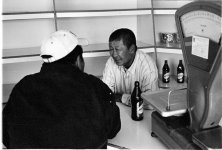foggie
the foggiest
Hi Dudes,
My printfile negative sleeves are still scratching my negatives. I opened a thread about this a year ago and did some more testing but am still getting scratches.
Here's my workflow
- develop film, rinse, etc
- hang-up negatives to dry in the tub. Close shower curtain and close door.
- in about 60-90 minutes, after the the last drop of water has dried, cut the negatives into 6-frame slices and put them into the printfile sleeves.
- squash negatives inside books underneath a pile of larger books. (TriX and Neopan has terrible curl.)
- 24 hours later scan them
I've noticed, and you can notice this on the attached example, that the first frame that gets slid into the sleeve gets scratched badly 10-20% of the way across the frame.
I've also noticed that this doesn't happen with my Arista EDU (Fomapan 100, iirc) but only with my Neopan and TriX. The difference between those films is that the fomapan dries completely flat and the others don't. When I noticed this I tried propping the printfile open with my finger so that it doesn't touch the plastic too much but I'm not sure it helped.
Someone earlier somewhere on this forum posted that you should wait 24 hours for the emulsion to harden. In my experience in Ulaanbaatar (dusty and dry) the negs just collect much more dust and gather even more scratches.
Any ideas on how to prevent them from happening? How much do such scratches show-up in prints? Some people have said scans accentuate scratches and others say enlargers+wet prints do.
My printfile negative sleeves are still scratching my negatives. I opened a thread about this a year ago and did some more testing but am still getting scratches.
Here's my workflow
- develop film, rinse, etc
- hang-up negatives to dry in the tub. Close shower curtain and close door.
- in about 60-90 minutes, after the the last drop of water has dried, cut the negatives into 6-frame slices and put them into the printfile sleeves.
- squash negatives inside books underneath a pile of larger books. (TriX and Neopan has terrible curl.)
- 24 hours later scan them
I've noticed, and you can notice this on the attached example, that the first frame that gets slid into the sleeve gets scratched badly 10-20% of the way across the frame.
I've also noticed that this doesn't happen with my Arista EDU (Fomapan 100, iirc) but only with my Neopan and TriX. The difference between those films is that the fomapan dries completely flat and the others don't. When I noticed this I tried propping the printfile open with my finger so that it doesn't touch the plastic too much but I'm not sure it helped.
Someone earlier somewhere on this forum posted that you should wait 24 hours for the emulsion to harden. In my experience in Ulaanbaatar (dusty and dry) the negs just collect much more dust and gather even more scratches.
Any ideas on how to prevent them from happening? How much do such scratches show-up in prints? Some people have said scans accentuate scratches and others say enlargers+wet prints do.


